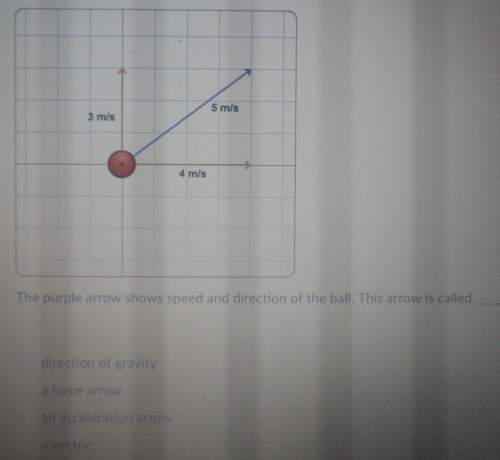The purple arrow shows speed and direction of the ball. this arrow is called
...

Physics, 25.06.2019 10:00, kylecharlton
The purple arrow shows speed and direction of the ball. this arrow is called


Answers: 2
Other questions on the subject: Physics


Physics, 21.06.2019 22:00, baileysosmart
Jason and mia are both running in a race. as they approach the finish line, you being the physicist that you are decide to time how long it takes them to reach the end of the race. when you start your stop watch (you can take this as time t = 0 s) you notice that mia is an unknown distance d ahead of jason and both are moving with the same initial velocity v_0. you also notice that jason is accelerating at a constant rate of a_j, while mia is deaccelerating at a constant rate of -a_m. jason and mia meet each other for the first time at time t = t_1. at this time (t = t_1) jason's velocity is two times that of mia's velocity, meaning v_j (t_1) = 2v_m (t_1). a) draw the position vs. time graph describing mia's and jason's motion from time t = 0 to time t = t_1. clearly label your axes and initial conditions on your graph. b) draw the velocity vs. time graph describing mia and jason's motion from time t = 0s to time t = t_1. clearly label your axes and initial conditions on your graph. c) how long from when the stop watch was started at t = 0s did it take mia and jason to meet? express your answer in terms of know quantities v_0, a_m, and a_j. d) when the stop watch started at time t = 0s, how far apart, d, were mia and jason? express your answer in terms of know quantities v_0, a_m, and a_j.
Answers: 1

Physics, 22.06.2019 02:30, jendun123ovrxij
The particle in a two-dimensional well is a useful model for the motion of electrons around the indole ring (3), the conjugated cycle found in the side chain of tryptophan. we may regard indole as a rectangle with sides of length 280 pm and 450 pm, with 10 electrons in the conjugated p system. as in case study 9.1, we assume that in the ground state of the molecule each quantized level is occupied by two electrons. (a) calculate the energy of an electron in the highest occupied level. (b) calculate the frequency of radiation that can induce a transition between the highest occupied and lowest unoccupied levels. 9.27 electrons around the porphine ring (4), the conjugated macrocycle that forms the structural basis of the heme group and the chlorophylls. we may treat the group as a circular ring of radius 440 pm, with 20 electrons in the conjugated system moving along the perimeter of the ring. as in exercise 9.26, assume that in the ground state of the molecule quantized each level is occupied by two electrons. (a) calculate the energy and angular momentum of an electron in the highest occupied level. (b) calculate the frequency of radiation that can induce a transition between the highest occupied and lowest unoccupied levels.
Answers: 1

Physics, 22.06.2019 09:00, keshho
When a bicycle coasts uphill, it moves slower and slower as it climbs. why? a. its kinetic energy is transforming into heat energy. b. its potential energy is transforming into kinetic energy. c. its kinetic energy is transforming into potential energy and heat energy. d. its potential energy is transforming into kinetic energy and heat energy.
Answers: 1
Do you know the correct answer?
Questions in other subjects:


Mathematics, 13.02.2020 03:31



Biology, 13.02.2020 03:31

Social Studies, 13.02.2020 03:31

Mathematics, 13.02.2020 03:31

Mathematics, 13.02.2020 03:31


History, 13.02.2020 03:31






